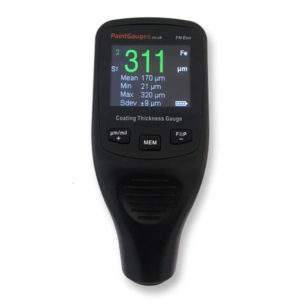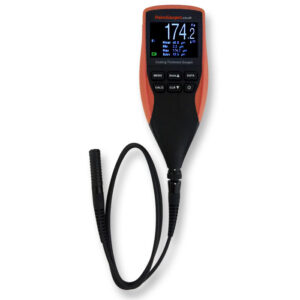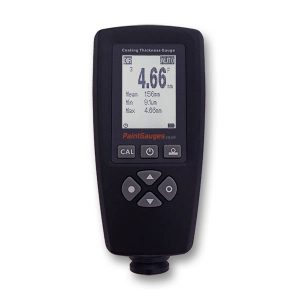Coating and paint thickness is important in substrate protection, cost, and aesthetic aspects. Coating thickness gauges enable quantitative precision measurement for inspection purposes.
What is coating thickness measurement?
Coating thickness measurement is the measurement of the thickness of a coating that has been applied to a substrate material. Our coating thickness gauges measure a variety of coating thicknesses on metal substrates. A common, but not the only application, is the measurement of the thickness of paint and consequently coating thickness gauges are often called paint thickness gauges (even though they can also measure thicknesses of coatings other than paint). Other common names used include paint depth gauge, paint gauge, paint meter, and coating gauge.
How can thicknesses of coatings be measured?
There are different methods to measure coating thicknesses. A key distinction is destructive testing versus non-destructive testing (NDT). In destructive testing a sample of coated material will be cut and the coating thickness inspected and measured at the cut interface. In non-destructive testing, the material and coating are intended to be left intact after measurement.
Our gauges are non-destructive test instruments.
What types of coatings can gauges measure the thickness of?
The capabilities of each of our gauges are listed on their individual product pages. However, depending on the specification of the individual gauge, examples of coatings that thicknesses of which can be measured include: paint, powder coating, fire resistant paint, rubber, plastic, enamel, vinyl, zinc plating on steel, chrome plating on steel, and anodising on aluminium.
More generally, a gauge with magnetic induction technology is designed to measure the thickness of non-magnetic coatings on ferrous substrates (e.g. steel). A gauge that has or also has eddy current technology is designed to measure the thickness of non-conductive coatings on non-ferrous substrates (e.g. aluminium).
How do coating thickness gauges measure the thickness of coatings?
There are a number of technical approaches to measuring coating thicknesses. Older designs used a mechanical approach which can lead to device accuracy being affected by physical wear and environmental factors. This includes magnetic pull-off type gauges that incorporate a permanent magnet and a spring.
Our coating thickness gauges are modern digital electronic gauges that incorporate magnetic induction and eddy current technology with digital displays and advanced features. They are non-destructive test (NDT) instruments designed to leave the surface intact after measurement of the coating thickness.
Stable probe placement
When taking a measurement it is important that the sensor probe of the coating thickness gauge is held in contact with the surface in a stable fashion.
If the sensor probe is held at an angle to the surface or there is movement of the probe during the measurement process an erroneous reading will result.
All of our gauges come with finger and thumb grips to aid secure holding of the gauge during the measuring process. Holding a gauge at its top rather than by these grips near the sensor at the bottom is likely to result in incorrect and unstable positioning of the probe against the surface.
Measuring on cylindrical or curved surfaces
Most of our coating thickness gauges (the FN Pro, FN Evo, FN CM and 156 USB) feature a v-notched sensor probe surround to aid in stable positioning on cylindrical surfaces. Positioning of the probe can be facilitated by aligning the v-notch perpendicular to the curvature of the cylinder.
Measuring on tacky or abrasive surfaces
In order to protect the sensor probe it is possible to use a calibrated thickness shim between the sensor probe and the coating surface to be measured. The thickness of the shim can then be subtracted from the final reading to give the measured thickness of the coating, taking into account any shim tolerance.
Care of your gauge
- Store the gauge in its case when it is not in use.
- Avoid contact with water or liquids. The sensor probe can be damaged or corrode if it gets wet and should be immediately dried if there is accidental contact with liquid.
- Never bang or tap the sensor probe against a surface. Position the probe gently against the surface to be measured and depress it until its surround is in stable contact with the coating to be measured.
- Avoid marking, denting or scratching the metal test blocks. To avoid causing surface irregularities, place the probe gently onto their surfaces when using them.
- Use only alkaline batteries in your gauge (not zinc or rechargeable batteries).
-
 FN Evo Coating Thickness Gauge£199.99
FN Evo Coating Thickness Gauge£199.99 -
 FN Ext Coating Thickness Gauge£299.99
FN Ext Coating Thickness Gauge£299.99 -
 FN Max Coating Thickness Gauge£329.99
FN Max Coating Thickness Gauge£329.99
